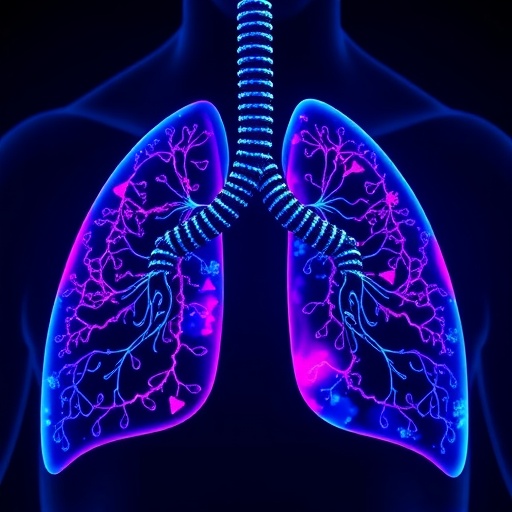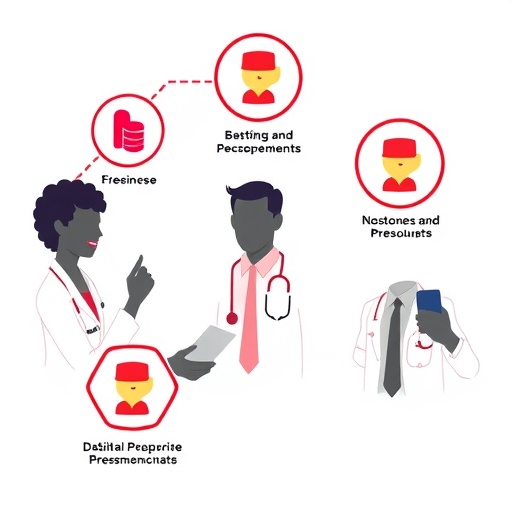In an unprecedented breakthrough, researchers have uncovered a revolutionary molecular mechanism behind chemoresistance in non-small cell lung cancer (NSCLC), focusing on a novel long non-coding RNA (lncRNA) named RP11-544M22.13. This discovery could signify a paradigm shift in our understanding of cancer metabolism and therapeutic resistance, potentially steering new strategies to combat one of the deadliest malignancies globally. NSCLC remains notoriously resistant to cisplatin, a cornerstone chemotherapy drug, and deciphering the underlying biology of this resistance is critical in enhancing patient outcomes.
The newly identified lncRNA, RP11-544M22.13, emerges as a pivotal regulatory molecule orchestrating glycolysis, the metabolic pathway leveraged aggressively by cancer cells to fuel their growth and survival. Xiong, Zhang, Pan, and their colleagues have detailed how this lncRNA modulates metabolic reprogramming in NSCLC, augmenting glycolysis in a manner that directly confers resistance to cisplatin-based therapy. Intriguingly, this metabolically driven resistance mechanism challenges conventional views that primarily attribute chemoresistance to DNA repair alterations or efflux pump overexpression.
At the cellular level, the elucidation of RP11-544M22.13’s role reveals a sophisticated regulatory network. This lncRNA appears to act as a molecular scaffold or regulator enhancing key glycolytic enzymes’ expression and activity, thereby accelerating the metabolic flux of glucose to lactate, even in oxygen-rich conditions—a phenomenon known as the Warburg effect. This augmented glycolysis not only sustains the energetic and anabolic demands of tumor cells but also creates a microenvironment hostile to cisplatin efficacy, possibly through alterations in intracellular pH, redox status, and drug uptake.
The research team employed cutting-edge transcriptomic and metabolomic profiling combined with rigorous in vitro and in vivo models to dissect the functional implications of RP11-544M22.13 expression. Knockdown experiments demonstrated a significant re-sensitization of NSCLC cells to cisplatin upon suppression of this lncRNA, strongly supporting its direct involvement in mediating therapeutic resistance. Conversely, overexpression models confirmed elevated glycolytic rates and concomitant resistance patterns, highlighting RP11-544M22.13 as a bona fide oncogenic metabolic modulator.
Mechanistically, the identification of RP11-544M22.13’s interaction with key regulatory proteins and metabolic enzymes unveils an intricate feedback loop where this RNA species likely influences transcriptional and post-transcriptional events. For instance, RP11-544M22.13 may stabilize mRNAs encoding critical enzymes such as hexokinase 2 (HK2) or pyruvate kinase M2 (PKM2), both integral to glycolytic progression and often upregulated in cancer. This mode of action exemplifies the increasingly appreciated role of lncRNAs as dynamic regulators in cancer biology, transcending their previously underestimated ‘non-coding’ categorization.
Importantly, these findings carry profound clinical implications. Chemoresistance has long remained a formidable barrier in NSCLC management, with limited therapeutic options upon failure of first-line cisplatin-based regimens. Targeting RP11-544M22.13 or its downstream metabolic axis opens the gateway to novel combinatorial therapies where metabolic vulnerabilities of tumor cells are exploited to overcome drug resistance. Conceptualizing inhibitors or RNA-based therapeutics specifically designed to antagonize RP11-544M22.13 could restore cisplatin sensitivity and improve survival rates.
Furthermore, this study underscores the importance of metabolic biomarkers in guiding personalized oncology. Quantitative assessment of RP11-544M22.13 levels could function as a predictive biomarker, identifying patients likely to exhibit primary or acquired resistance to cisplatin. This strategic biomarker-driven approach aligns with precision medicine goals, allowing clinicians to tailor treatment regimens based on tumor metabolic profiling rather than relying on empirical chemotherapy alone.
Beyond NSCLC, this paradigm may extend to other malignancies where glycolysis-driven chemoresistance is evident. The universality of metabolic rewiring in cancer suggests that lncRNAs like RP11-544M22.13 could serve as master regulators across diverse tumor types. Consequently, the translational potential of this research is vast, warranting broader investigative efforts aimed at lncRNA-mediated metabolic control mechanisms.
Technologically, the integration of high-throughput sequencing, RNA interference, CRISPR gene editing, and metabolic assays fostered a comprehensive understanding of RP11-544M22.13’s functions. Such multidisciplinary approaches exemplify the future trajectory of cancer biology research wherein genomics meets metabolomics to unravel complex phenotypes and identify actionable targets.
The characterization of RP11-544M22.13 also offers insights into noncoding genome functionality, which has historically been deemed ‘junk DNA’. This growing recognition of lncRNAs as key players in oncogenic pathways redefines molecular oncology, further justifying large-scale efforts like ENCODE to decode the noncoding genome’s regulatory landscapes.
In summary, the revelation of lncRNA RP11-544M22.13 as a glycolysis enhancer driving cisplatin resistance revolutionizes our perception of metabolic contributions to chemoresistance in NSCLC. By illuminating this link, the study pioneers a new frontier in therapeutic strategy development focused on metabolic modulation and RNA biology. If harnessed effectively, these advances promise to transform clinical practice, offering renewed hope for patients grappling with resistant lung cancer.
As research continues to unravel the complexities of metabolic regulation in cancer, the identification of RP11-544M22.13 pushes the envelope, advocating for integrative cancer therapies that combine metabolic inhibitors with conventional chemotherapeutics. This holistic approach may ultimately overcome the longstanding challenge of chemoresistance and lead to durable remission for many.
The publication of these findings in Cell Death Discovery further emphasizes their significance, as the journal is renowned for disseminating discoveries that redefine cellular and molecular underpinnings of disease. Given the global burden of NSCLC and the critical need for novel interventions, the spotlight on RP11-544M22.13 heralds a momentous leap forward.
Future investigations will need to explore how RP11-544M22.13 interplays with other metabolic and signaling networks, including hypoxia-inducible factors, PI3K/Akt pathway, and epigenetic regulators. Understanding these intersections will deepen our grasp of tumor adaptability and resistance evolution.
In addition, clinical trials assessing the safety and efficacy of agents targeting the RP11-544M22.13 axis are eagerly anticipated. The transition from bench to bedside will mark a definitive step toward precision oncology tailored to tumor metabolism.
Ultimately, the discovery of RP11-544M22.13 exemplifies the transformative power of RNA biology in cancer management. As scientists continue to decode the intricacies of tumor metabolism, lncRNAs stand out as promising therapeutic entry points, offering fresh avenues to surmount the formidable challenge of chemoresistance.
Subject of Research:
The study investigates the role of a novel long non-coding RNA, RP11-544M22.13, in promoting glycolysis-mediated cisplatin resistance in non-small cell lung cancer.
Article Title:
A novel lncRNA RP11-544M22.13 enhances glycolysis-induced cisplatin resistance in non-small cell lung cancer.
Article References:
Xiong, J., Zhang, H., Pan, Z. et al. A novel lncRNA RP11-544M22.13 enhances glycolysis-induced cisplatin resistance in non-small cell lung cancer. Cell Death Discov. (2025). https://doi.org/10.1038/s41420-025-02873-3
Image Credits: AI Generated
DOI: https://doi.org/10.1038/s41420-025-02873-3
Tags: cancer cell survival strategieschemoresistance in lung cancercisplatin resistance pathwaysenhancing patient outcomes in lung cancerglycolysis and cancer metabolismlncRNA RP11-544M22.13long non-coding RNA researchmetabolic reprogramming in cancermolecular mechanisms of drug resistancenon-small cell lung cancer mechanismsregulatory networks in cancer biologytherapeutic strategies for NSCLC





